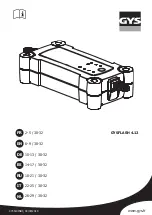
Page
10
of
22
3. Install the left front splash guard with one of the supplied self-tapping screws and the three self-tapping screws
you removed in step 2 in the order shown.
4. Make sure there is no gap between the splash guard and the body. If there is, loosen the four self-tapping
screws, hold the splash guard against the body, and tighten the screws.
5. Turn the steering wheel all the way to the right, and repeat steps 2 thru 4 for the right front splash guard.
Vehicle Exterior (Vehicle Lowered to Ground)
11.
Set the Tire Pressures
To prevent flat spots during vehicle shipping and storage, the tires are inflated to over 40 psi. Adjust the tire pressures
to the cold inflation values listed on the driver’s doorjamb label. If you are in a cold climate region, make sure the tires
are at the outside ambient temperature before adjusting the pressures; otherwise, the Low Tire Pressure/TPMS
indicator may come on in cold weather.
NOTE: There is no spare tire. This vehicle comes with a tire repair kit stored under the trunk lining. An optional spare
tire can be ordered separately.
12.
Initialize the Tire Pressure Monitoring System (TPMS)
If the Low Tire Pressure/TPMS indicator stays on with the ignition turned to ON, do this to initialize the system:
1. Start the engine, then turn it off.
2. Wait 25 seconds.
3. Repeat steps 1 and 2 three times.
4. Check the TPMS message in the MID; the tire pressure readings should be normal. If they are abnormally high,
check for DTCs with the HDS.








































